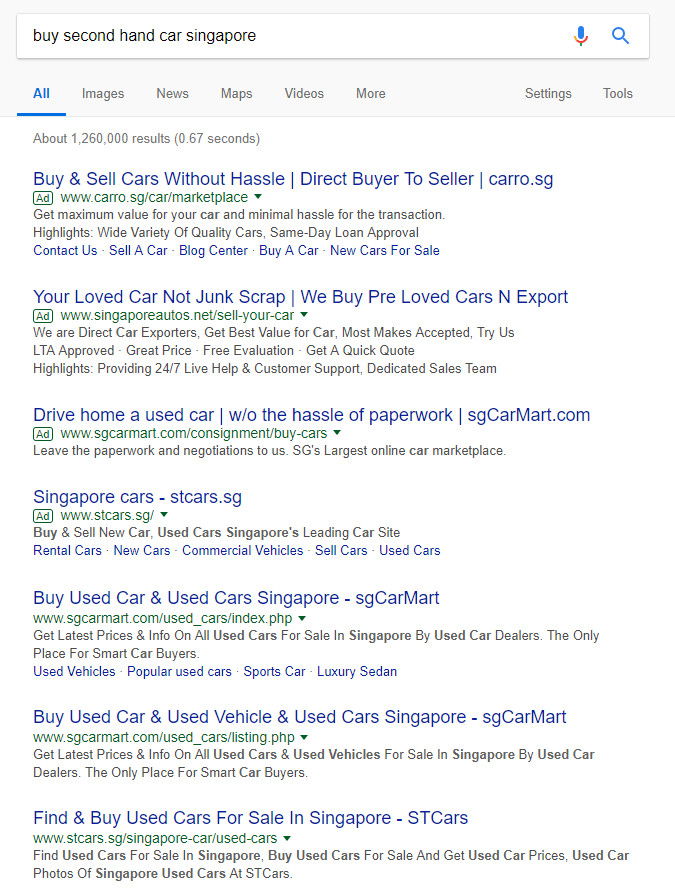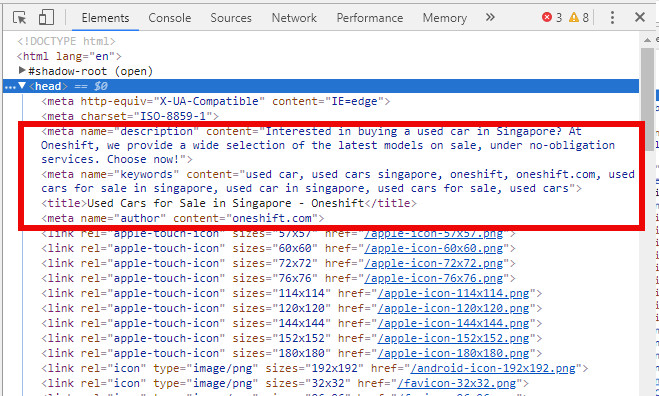This article is for non-technical people who want to increase visitors from search engines to their webpage. TLDR: Employing basic copywriting principles to attract visitors and adding meta tags in your webpage’s HTML.

People are scanners
Faced with a list of results, people usually scan for words that attract them, or are relevant, before they click on a particular listing. Hence, we’re going to focus on how you can write your page content (specifically your page title, description, keywords) to attract more people to click on your webpage from search engines.
(To understand what affects your webpage’s placing in Google’s search results, you can take a look at 4 factors here.)
Attracting visitors with your search listing text
Consider this example. Someone’s looking to buy a secondhand car in Singapore:

The first few results are usually taken up by paid ads, i.e. companies paying and using Google Adwords to be placed up there.
Personally, whenever I use Google to search for information nowadays, especially if I’m looking to buy something, I tend to ignore the first few results because I know that they are paid ads and the product prices here aren’t necessarily the most value for money. I suspect this is true for other savvy users.
Besides mentally filtering the first few ads, I scan the page of listings, reading or rather scanning their titles and descriptions as fast as I can (since I’m not here to waste time) and clicking on the one I find most desirable.
Take a look at the results here, or in the photo below. Notice which texts (the titles and descriptions) are easier to read and appeal to you.

Did you mentally tune out for a while? That’s how humans react when they see something that’s not relevant to them or is boring. It’s called selective attention. But bear with me and just look at that list of results again.
Notice how almost all the listing titles are capitalised title style. This means the first letter of each word is capitalised. This makes the listing look more official (rather than casual), more credible and more authoritative. Like these:
The titles all contain the keywords or related terms to my search (“buy” + “car” + “singapore” and “second hand” became “used”) and they also contain the website name, so that you know straightaway which website is it.
But, notice how the description texts are different. Some contain links, usually the paid ads, and some don’t. And you should also see that some description text is written in the capitalised title style.
Based on readability studies, lower case text is the easiest to read. So in this case, when the chunk of text is written in title case, you’re making your potential visitors work harder to understand what you’re saying.
It’s Like Having A Whatsapp Conversation Which Someone Who Types Like This!
So don’t do that.
Good Copywriting for your Page Description
Consider the example from Oneshift.com which attracted me even though it was at the lower half of the page results: “Interested in buying a used car in Singapore? At Oneshift, we provide a wide selection of the latest models on sale, under no-obligation services. Choose now!”
“Interested in buying a used car in Singapore? At Oneshift, we provide a wide selection of the latest models on sale, under no-obligation services. Choose now!”
I think the text description here is good. The tone is conversational instead of being too hardsell and it lends an air of familiarity and recognises what the user is looking for by repeating the keywords back at us (Interested in buying a used car in Singapore?).
It also emphasises their product variety/range and affordability (wide selection of latest models on sale) and also reassures those of us who are adverse to sticky salespersons (under no-obligation services), plus an ending call to action (Choose now!).
How to apply these to your webpage HTML
Take a look at the webpage at Oneshift.com, you can click on developer settings and look at the HTML code at the page.

Notice the meta tags at this section:

Note: this only applies for the webpage on ‘Used Cars’. Do no repeat the same text for your ‘New Cars’ or its equivalent page. Obviously, pages with different content should have different meta tags that market them to search engines and visitors.
So the takeaway here is if your website CMS (content management system) supports editing of page title/descriptions/keywords, it’s good practice to make sure they’re easily-readable, and appeal to your customers with their needs in mind and how your product benefits them.
This practice will also help enhance your content in terms of SEO; enable search engines to better index your site, and place it higher in search results.
To learn more about meta tags, you can check out this page.
